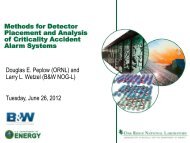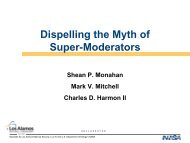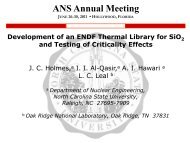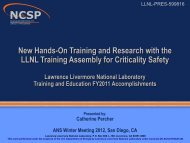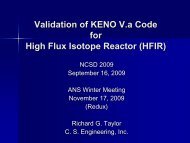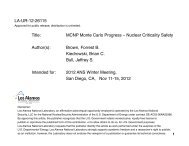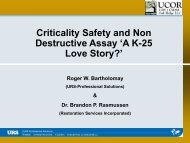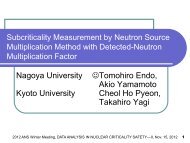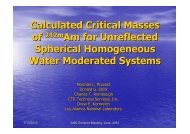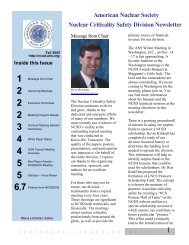k-Effective of the World - Nuclear Criticality Safety Division
k-Effective of the World - Nuclear Criticality Safety Division
k-Effective of the World - Nuclear Criticality Safety Division
Create successful ePaper yourself
Turn your PDF publications into a flip-book with our unique Google optimized e-Paper software.
X-Computational<br />
Physics Div.<br />
XCP-3, LANL<br />
LA-UR-11-03593<br />
Statistical Coverage Concerns in a<br />
Revised k-<strong>Effective</strong> <strong>of</strong> <strong>the</strong> <strong>World</strong><br />
Problem<br />
Brian Kiedrowski, Forrest Brown<br />
Los Alamos National Laboratory<br />
X-Computational Physics <strong>Division</strong><br />
1
Abstract<br />
X-Computational<br />
Physics Div.<br />
XCP-3, LANL<br />
A revised version <strong>of</strong> k-<strong>Effective</strong> <strong>of</strong> <strong>the</strong> <strong>World</strong> is defined specifically to stress<br />
current Monte Carlo power iteration techniques. Results <strong>of</strong> numerous<br />
independent Monte Carlo calculations show that even for batch sizes that are<br />
typically considered reasonable (5-10K), incorrect results for k are obtained with<br />
non-trivial probability. The causes for what makes a problem prone to having<br />
<strong>the</strong>se difficulties are identified and advice for criticality safety practitioners is<br />
provided.<br />
2
Overview<br />
X-Computational<br />
Physics Div.<br />
XCP-3, LANL<br />
• Review <strong>of</strong> k-<strong>Effective</strong> <strong>of</strong> <strong>the</strong> <strong>World</strong><br />
• The Revised Problem<br />
• Numerical Results<br />
• Analysis & Guidance<br />
3
X-Computational<br />
Physics Div.<br />
XCP-3, LANL<br />
Review <strong>of</strong> k-<strong>Effective</strong> <strong>of</strong> <strong>the</strong> <strong>World</strong><br />
4
Problem Specification<br />
X-Computational<br />
Physics Div.<br />
XCP-3, LANL<br />
• Proposed by E. Whitesides in 1971<br />
• Specification:<br />
– 9 x 9 x 9 array <strong>of</strong> Pu-239 spheres spaced 50 cm apart in<br />
vacuum<br />
– The array is surrounded by a thick water reflector and is<br />
subcritical<br />
– Replace central sphere with one that is exactly critical by<br />
itself<br />
– Final result should be supercritical<br />
5
Results<br />
X-Computational<br />
Physics Div.<br />
XCP-3, LANL<br />
• MCNP5-1.60 + ENDF/B-VII.0 data<br />
• For uniform array <strong>of</strong> identical spheres<br />
with surrounding water, sphere radii<br />
adjusted to r = 3.9 cm, so that<br />
Keff = .9328 ± .0002<br />
• Single bare sphere, r=4.928 cm,<br />
Keff = 1.0001 ± .0002<br />
• Whitesides' model problem:<br />
Replace center sphere <strong>of</strong> array<br />
by larger (critical) sphere<br />
Should be supercritical - is it <br />
6
Results: Then and Now<br />
X-Computational<br />
Physics Div.<br />
XCP-3, LANL<br />
• Run problem multiple times with different random<br />
number sequence<br />
• KENO defaults in <strong>the</strong> 1970s:<br />
– 300 particles per cycle, skip 3, run 100 active cycles<br />
– Results yield k as being subcritical<br />
• Modern best practices:<br />
– Use 5000+ particles per cycle, analyze convergence<br />
diagnostics, start particles in each region<br />
– Results yield correct k as supercritical<br />
7
Results<br />
X-Computational<br />
Physics Div.<br />
XCP-3, LANL<br />
Distribution <strong>of</strong> K eff for 200 replicas, various M = neutrons/cycle<br />
Frequency <strong>of</strong> Keff, for replicas<br />
M=200<br />
M=300<br />
M=10K<br />
M=500<br />
Keff<br />
8
Convergence<br />
X-Computational<br />
Physics Div.<br />
XCP-3, LANL<br />
K eff vs cycle, various M<br />
M = neutrons/cycle<br />
H src vs cycle, various M<br />
M = neutrons/cycle<br />
K eff converges in<br />
75-100 cycles<br />
M = 10,000<br />
M = 10,000<br />
H src converges in<br />
100-150 cycles<br />
M = 5,000<br />
M = 5,000<br />
Must discard 150<br />
or more initial<br />
cycles<br />
M = 1,000<br />
M = 1,000<br />
Convergence<br />
depends on <strong>the</strong><br />
dominance ratio &<br />
source guess, NOT<br />
on neutrons/cycle<br />
M = 500<br />
M = 500<br />
100 200<br />
100 200<br />
Initial source guess = uniform sampling <strong>of</strong> points at sphere centers<br />
9
Results Explained<br />
X-Computational<br />
Physics Div.<br />
XCP-3, LANL<br />
• Problem has 729 spheres, 300 per cycle not enough to<br />
sample problem space!<br />
– Problem <strong>of</strong> coverage<br />
• Small batch size leads to issues in normalization<br />
– Problem <strong>of</strong> non-conservative bias<br />
• About 150 cycles required to find a steady source<br />
– Problem <strong>of</strong> convergence<br />
• Modern best practices make this problem easy to solve<br />
10
X-Computational<br />
Physics Div.<br />
XCP-3, LANL<br />
The Revised Problem<br />
11
A More Difficult Problem<br />
X-Computational<br />
Physics Div.<br />
XCP-3, LANL<br />
• Simulate a flooded subcritical assembly storage vault<br />
• Flood <strong>the</strong> area between <strong>the</strong> spheres, reduce radii and<br />
distances between spheres to retain criticality<br />
– Decreases coupling between spheres<br />
• Place a thick layer <strong>of</strong> natural cadmium around <strong>the</strong><br />
central (most reactive) sphere<br />
– Creates an asymmetry in coupling between <strong>the</strong> most<br />
reactive region and <strong>the</strong> o<strong>the</strong>r region<br />
• These coupling characteristics create difficulties<br />
12
Problem Specifications<br />
X-Computational<br />
Physics Div.<br />
XCP-3, LANL<br />
• Geometric Specifications:<br />
– Radius <strong>of</strong> non-central Pu-239 spheres: 3.75 cm<br />
– Radius <strong>of</strong> central Pu-239 sphere: 4.33 cm<br />
– Coating thickness: 0.5 cm<br />
– Center-to-center spacing: 20 cm<br />
• Material specifications:<br />
– Pure Pu-239, density: 20.0 g/cc<br />
– Natural cadmium, density: 8.65 g/cc<br />
– Pure water, density: 1.0 g/cc<br />
13
Problem Specification<br />
X-Computational<br />
Physics Div.<br />
XCP-3, LANL<br />
• Source specification<br />
– Uniformly sample points in each sphere<br />
– 500 inactive cycles, 1000 total<br />
– Vary size <strong>of</strong> batch<br />
• <strong>Criticality</strong> results for variants:<br />
– Uniform array: keff = 0.95<br />
– Larger, coated sphere in infinite water bath: keff = 1.0<br />
– Composite system should be supercritical<br />
14
Problem Specification<br />
X-Computational<br />
Physics Div.<br />
XCP-3, LANL<br />
15
X-Computational<br />
Physics Div.<br />
XCP-3, LANL<br />
Numerical Results<br />
16
Reliability Tests<br />
X-Computational<br />
Physics Div.<br />
XCP-3, LANL<br />
• Main Observation: MCNP (and any o<strong>the</strong>r package using<br />
power iteration) produces unreliable results<br />
– Sometimes correct (k > 1.0), sometimes wrong (k = 0.95)<br />
– Reliability increases with size <strong>of</strong> batch<br />
– A “good” starting source is important<br />
• Reliability is defined as <strong>the</strong> probability <strong>of</strong> getting <strong>the</strong><br />
correct answer<br />
– Determine with 100 independent MCNP trials with different<br />
random number sequences<br />
• Try to explain why…<br />
17
Probability Density <strong>of</strong> Results<br />
X-Computational<br />
Physics Div.<br />
XCP-3, LANL<br />
0.35<br />
0.3<br />
0.25<br />
0.2<br />
0.15<br />
0.1<br />
0.05<br />
0<br />
5K<br />
20K<br />
10K<br />
18
Reliability Curve<br />
X-Computational<br />
Physics Div.<br />
XCP-3, LANL<br />
1.0<br />
0.9<br />
Frequency <strong>of</strong> Incorrect k<br />
0.8<br />
0.7<br />
0.6<br />
0.5<br />
0.4<br />
0.3<br />
0.2<br />
0.1<br />
0.0<br />
0 5 10 15 20 25<br />
Batch Size (1000 neutrons/cycle)<br />
19
X-Computational<br />
Physics Div.<br />
XCP-3, LANL<br />
Analysis & Guidance<br />
20
Discussion <strong>of</strong> Results<br />
X-Computational<br />
Physics Div.<br />
XCP-3, LANL<br />
• Best practices<br />
– Batch size 5K or more may be too small<br />
– May require 100K+ for “difficult” problems<br />
• Probability <strong>of</strong> getting incorrect k decreases<br />
exponentially with batch size<br />
• No observable impact <strong>of</strong> bias<br />
– Mean value for “correct” peak has consistent average k<br />
– Problem is coverage not bias<br />
21
Discussion <strong>of</strong> Results<br />
X-Computational<br />
Physics Div.<br />
XCP-3, LANL<br />
• Diagnostics <strong>of</strong>ten fail to detect coverage<br />
– Convergence in k plot is false<br />
– Shannon entropy <strong>of</strong>fers little to no indication<br />
– Possible to sample central sphere, but not initiate a sustaining<br />
fission chain<br />
• Prescribed source guess inadequate<br />
– Source guess points in central sphere guarantees<br />
convergence to correct k<br />
22
Recipe for a “Difficult” Problem<br />
X-Computational<br />
Physics Div.<br />
XCP-3, LANL<br />
• Loosely-coupled regions<br />
• Varying importance<br />
– Most important region MUST be adequately sampled<br />
• Asymmetric coupling<br />
– Arises from material or geometric effects<br />
23
Asymmetric Coupling<br />
X-Computational<br />
Physics Div.<br />
XCP-3, LANL<br />
24
Practical Guidance<br />
X-Computational<br />
Physics Div.<br />
XCP-3, LANL<br />
• Understand <strong>the</strong> problem<br />
– Exercise caution for problems with discrete zones<br />
– Identify most important region(s)<br />
• Good parameters defeats many problems<br />
– Large batch sizes (100K+) preferable<br />
– Source guess focus on most important region(s)<br />
• Analyze results closely<br />
– Check population tables to ensure adequate sampling<br />
– Does value <strong>of</strong> k match your intuition<br />
– For suspicious outcomes, run again with different random<br />
number seeds<br />
25
References<br />
X-Computational<br />
Physics Div.<br />
XCP-3, LANL<br />
• X-5 MONTE CARLO TEAM, “MCNP – A<br />
General N-Particle Transport Code, Version<br />
5 – Volume I: Overview and Theory,” LA-<br />
UR-03-1987, Los Alamos National<br />
Laboratory (2003).<br />
• G.E. WHITESIDES, "Difficulty in Computing<br />
<strong>the</strong> k-effective <strong>of</strong> <strong>the</strong> <strong>World</strong>," Trans. Am.<br />
Nucl. Soc., 14, No. 2, 680 (1971).<br />
• F.B. BROWN, "Review <strong>of</strong> Best Practices for<br />
Monte Carlo <strong>Criticality</strong> Calculations", ANS<br />
NCSD-2009, Richland, WA, Sept 13-17<br />
(2009).<br />
• F.B. Brown, “’K-<strong>Effective</strong> Of The <strong>World</strong>’<br />
And O<strong>the</strong>r Concerns For Monte Carlo<br />
Eigenvalue Calculations”, SNA+MC-2010,<br />
Tokyo, Oct 17-20 [also, LA-UR-10-05548]<br />
• R.N. Blomquist, et al., "Source<br />
Convergence in <strong>Criticality</strong> <strong>Safety</strong> Analysis,<br />
Phase I: Results <strong>of</strong> Four Test Problems,"<br />
OECD <strong>Nuclear</strong> Energy Agency, OECD NEA<br />
No. 5431 (2006).<br />
• R.N. Blomquist, et al., "NEA Expert Group<br />
on Source Convergence Phase II:<br />
Guidance for <strong>Criticality</strong> Calculations", 8 th<br />
International International Conference on<br />
<strong>Criticality</strong> <strong>Safety</strong>, St. Petersburg, Russia,<br />
May 28 – June 1, 2007 (May 2007).<br />
• F.B. Brown, “Revisiting <strong>the</strong> ‘K-effective <strong>of</strong><br />
<strong>the</strong> <strong>World</strong>’ Problem”, Trans. Am. Nuc. Soc,<br />
102, June 2010, [also, LA-UR-10-00189]<br />
(2010).<br />
• F.B. Brown, B.C. Kiedrowski, J.S. Bull,<br />
"MCNP5-1.60 Release Notes", LA-UR-10-<br />
06235 (2010).<br />
26
X-Computational<br />
Physics Div.<br />
XCP-3, LANL<br />
Questions<br />
27




